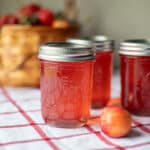Crabapple Jelly
Not only is this is a quick, easy, and delicious crabapple jelly recipe, but I'll also show you how to use the leftover pulp to make delicious crabapple sauce!
Servings: 56 servings
Calories: 66kcal
Equipment
- 1 food mill (optional)
Ingredients
- 4 lbs crabapples
- 5 cups water
- 1 medium lemon (juiced)
- 3½ cups granulated sugar (adjust based on juice amount)
Instructions
- Add 5 cups of water to a large Dutch oven, then juice a medium lemon and add the juice to the water. Next, wash and sort the crabapples. Toss out any that are badly damaged.
- Remove stems and blossom ends then quarter crabapples to make sure there is no worm damage. If there is, simply remove the area that's affected, or toss out if too badly damaged.
- Weigh chopped apples using a food scale until you have 1 pound, then transfer to the pot of water. The lemon juice will keep the crabapples from discoloring while you work on the rest of the crabapples, transferring 1 lb at a time, until you have 4 pounds in total.
- Bring the apple and water mixture to a boil over medium-high heat. Reduce heat and simmer for an additional 15-20 minutes or until the apples begin to fall apart. Mash with a potato masher until the apples collapse.
- (optional step) If you plan on water bath canning the crabapple jelly, fill your water bath canner (or a large pot) with cold water. Add four 8-ounce canning jars or eight 4-ounce jars. You may have an extra jar, depending on how much juice is extracted from the apples.
- Use a jelly bag to strain the liquid from the apples, then compost the solids, or use a food mill to separate the skins and seeds from the pulp, then strain the juice from the pulp. With this option, you can use the remaining pulp to make crabapple sauce! I recommend the second option.
- Measure strained liquid and pour into the same (now clean) Dutch oven. Bring juice to a boil, then stir in an equal amount of sugar. Bring juice to a rolling boil, add candy thermometer, and cook until it reaches the proper temperature, based on your elevation. See chart in post.
- Skim foam off surface, then ladle hot jelly into sterilized mason jars, leaving ¼ inch headspace. Wipe rims with a clean dishcloth, then add lids. Screw bands hand tight, then use jar lifter to lower filled jars into the canner. Process jelly based on your elevation. See chart in post.
- Remove jars from canner and place on a rack or a dishtowel on the counter. Wait until they seal before labeling them. Store sealed jars in the pantry for up to a year. Place unsealed jars in the fridge.
- See post for directions on how to make applesauce with the pulp!
Notes
- Straining the juice through a jelly bag or a colander lined with a few layers of cheesecloth can take up to a few hours, but will result in clear jelly. If you squeeze the bag to speed up the process (guilty) you'll have a more cloudy jelly, but it still tastes great!
- When processing the crabapples, I like to leave the skin on and seeds intact since both contain pectin to help thicken the jelly.
- It is not recommended to double or triple any jelly recipe because it can affect how the jelly sets.
- Do not reduce the amount of sugar suggested in this recipe, it may cause the jelly not to set.
Nutrition
Serving: 1tablespoon | Calories: 66kcal | Carbohydrates: 17g | Protein: 0.1g | Fat: 0.1g | Sodium: 1mg | Fiber: 1g | Sugar: 16g
